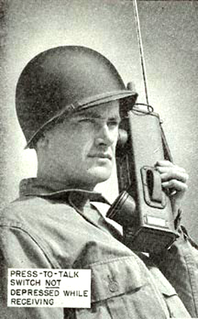
In aviation, the instrument landing system (ILS) is a precision radio navigation system that provides short-range guidance to aircraft to allow them to approach a runway at night or in bad weather. In its original form, it allows an aircraft to approach until it is 200 feet (61 m) over the ground, within a 1⁄2 mile (800 m) of the runway. At that point the runway should be visible to the pilot; if it is not, they perform a missed approach. Bringing the aircraft this close to the runway dramatically increases the range of weather conditions in which a safe landing can be made. Other versions of the system, or "categories", have further reduced the minimum altitudes, runway visual ranges (RVRs), and transmitter and monitoring configurations designed depending on the normal expected weather patterns and airport safety requirements.

A non-directional (radio) beacon (NDB) is a radio transmitter at a known location, used as an aviation or marine navigational aid. As the name implies, the signal transmitted does not include inherent directional information, in contrast to other navigational aids such as low-frequency radio range, VHF omnidirectional range (VOR) and tactical air navigation system (TACAN). NDB signals follow the curvature of the Earth, so they can be received at much greater distances at lower altitudes, a major advantage over VOR. However, NDB signals are also affected more by atmospheric conditions, mountainous terrain, coastal refraction and electrical storms, particularly at long range. The system, developed by United States Air Force (USAF) Captain Albert Francis Hegenberger, was used to fly the world's first instrument approach on May 9, 1932.

A marker beacon is a particular type of VHF radio beacon used in aviation, usually in conjunction with an instrument landing system (ILS), to give pilots a means to determine position along an established route to a destination such as a runway.

The AN/ARC-5 Command Radio Set is a series of radio receivers, transmitters, and accessories carried aboard U.S. Navy aircraft during World War II and for some years afterward. It is described as "a complete multi-channel radio transmitting and receiving set providing communication and navigation facilities for aircraft. The LF-MF-HF components are designed to transmit and receive voice, tone-modulated, and continuous wave (cw) signals." Its flexible design provided AM radiotelephone voice communication and Modulated continuous wave (MCW) and Continuous wave (CW) Morse code modes, all of which are typical capabilities in other Navy aircraft communication sets of the period. It was an improvement of the Navy's ARA/ATA command set. Similar units designated SCR-274-N were used in U.S. Army aircraft. The Army set is based on the ARA/ATA, not the later AN/ARC-5. The ARA/ATA and SCR-274-N series are informally referred to as "ARC-5", despite small differences that render all three series incompatible. Like the AN/ARC-5, the ARA/ATA and SCR-274-N had AM voice communication and two-way MCW and CW Morse code capability.

The SCR-284 was a World War II era combination transmitter and receiver used in vehicles or fixed ground stations.
The Lorenz beam was a blind-landing radio navigation system developed by C. Lorenz AG in Berlin. The first system had been installed in 1932 at Berlin-Tempelhof Central Airport, followed by Dübendorf in Switzerland (1934) and others all over the world. The Lorenz company referred to it simply as the Ultrakurzwellen-Landefunkfeuer, German for "ultra-short-wave landing radio beacon", or LFF. In the UK it was known as Standard Beam Approach (SBA).

In navigation, a radio beacon or radiobeacon is a kind of beacon, a device that marks a fixed location and allows direction-finding equipment to find relative bearing. But instead of employing visible light, radio beacons transmit electromagnetic radiation in the radio wave band. They are used for direction-finding systems on ships, aircraft and vehicles.
During World War II, the German Luftwaffe relied on an increasingly diverse array of electronic communications, IFF and RDF equipment as avionics in its aircraft and also on the ground. Most of this equipment received the generic prefix FuG for Funkgerät, meaning "radio equipment". Most of the aircraft-mounted Radar equipment also used the FuG prefix. This article is a list and a description of the radio, IFF and RDF equipment.

The SCR-536 was a hand-held radio transceiver used by the US Army Signal Corps in World War II. It is popularly referred to as a walkie talkie, although it was originally designated a "handie talkie".

Signal Corps Radios were U.S. Army military communications components that comprised "sets". Under the Army Nomenclature System, the abbreviation SCR initially designated "Set, Complete Radio", but was later misinterpreted as "Signal Corps Radio."

The SCR-299 was a U.S. Signal Corps mobile military communications unit used during World War II.

Survival radios are carried by ships and aircraft to facilitate rescue in an emergency. They are generally designed to transmit on international distress frequencies. Maritime systems have been standardized under the Global Maritime Distress Safety System.

The SCR-300 was a portable radio transceiver used by US Signal Corps in World War II. This backpack-mounted unit was the first radio to be nicknamed a "walkie talkie".
The AN/MPN is a mobile Ground-controlled approach radar first used during World War II. "MPN" is Joint Electronics Type Designation System nomenclature for (Ground) Mobile (M), Pulsed (P), Navigation aid (N).

The SCR-694 was a portable two way radio set used by the U.S. military during World War II.

The SCR-277 was a mobile, trailer mounted radio range set for radio guidance of aircraft. It was standardized by the U.S. Army in June 1941.

The BC-342 was a World War II U.S. Army Signal Corps high frequency radio receiver. It was used primarily as part of field installations such as the SCR-188A, but could be used with mobile sets such as the 2 1/2 ton mounted SCR-399. First designed at Fort Monmouth, New Jersey by the U.S. Army Signal Corps, it was built by various manufacturers including RCA. Many of the later units that are encountered today were manufactured by the Farnsworth Television and Radio Corporation of Fort Wayne, Indiana. Variants include the low frequency coverage BC-344 receiver, and the battery or dynamotor powered BC-312 receiver.
The AN/MRN-1 was an instrument approach localizer used by the Army Air Force during and after World War II. It was standardized on 3 July 1942. It replaced the SCR-241, and was a component of SCS-51.

The SCR-245 Radio was a mobile MF/HF Signal Corps Radio used by the U.S. Army before and during World War II, for short range ground communications, It was one of the first crystal controlled sets used by the Army.

The SCR-508 radio was a mobile Signal Corps Radio used by the U.S. Army during World War II, for short range ground communications. The SCR-508 series radio represented the Army's commitment to both FM and crystal tuning, and was used extensively by armor and mechanized units. The turret bustle of late series light and medium tanks was designed around this radio.















